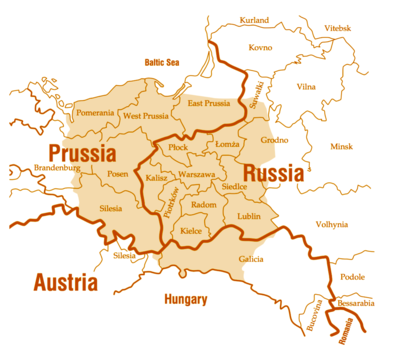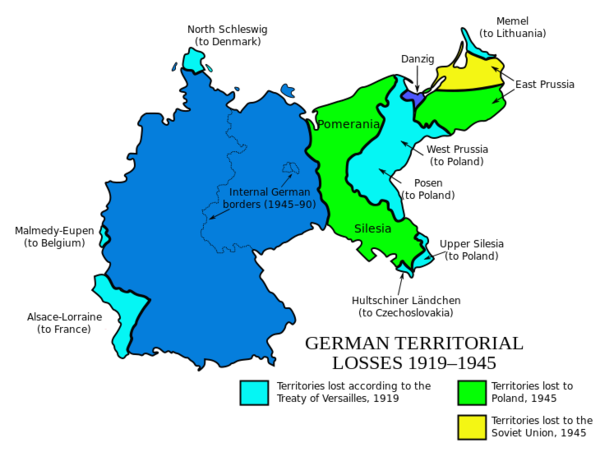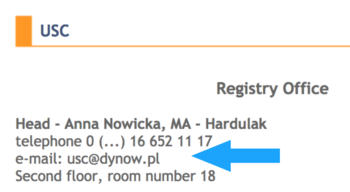Prussian Poland Civil Registration
| Prussian Poland Wiki Topics | |
_Lob.svg.png)
| |
| Beginning Research | |
| Record Types | |
| Moderator | |
|
| |
Definition[edit | edit source]
- Civil registration is the vital records (records of births, marriages, and deaths) made by the government. Civil registration records (zapisy cywilne) are an excellent source for information on names, dates, and places of births, marriages, and deaths.
- Legally, civil records were to be kept by state officials. Because there were not enough state officials, the clergy were frequently appointed as civil registrars. The clergy were required to make civil copies of birth, marriage, and death records. These are known as "civil transcripts of church records" (see Poland Church Records).
- Because the church was involved in early civil registration, it is difficult to clearly distinguish between civil registration and church records.
|
In 1795, the old Kingdom of Poland was conquered and divided among Russia, Austria, and Prussia. Civil registration coverage varied for each part of Poland controlled by Russia, Prussia, or Austria. This article covers information about civil registration in the Prussian-controlled part of Poland. For the other parts of Poland, see: |
 |
Time Coverage[edit | edit source]
Civil authorities in the German territories of Poland began registering births, marriages, and deaths in 1874. The people were required to report all births, marriages, and deaths to a civil registrar (Standesamt).
Language of the Records[edit | edit source]
From 1874 to 1918, records were kept in German. Some areas were annexed to Poland after World War I, and began using Polish. After 1945, all those areas were annexed and using Polish.

Information Recorded in Civil Registers[edit | edit source]
Information recorded in Prussian civil registration records was quite standardized. German forms were used, which required specific details.
Prussian Birth Records (Geburten, akta urodzeń)[edit | edit source]
Birth records usually give:
- the child’s name,
- sex,
- date and place of birth,
- and parents’ names.
They sometimes give:
- the age of the parents,
- occupation of the father, and
- marital status of mother.
Births were generally registered within a day of the child’s birth by the father, a neighbor of the family, or the midwife. Corrections to a birth record may have been added as a marginal note, sometimes years later.
Prussian Marriage Records (Heiraten, akta małżeństw)[edit | edit source]
Marriages were often recorded in the parish where the bride lived. After 1874 Prussian law required a civil marriage ceremony in addition to a church ceremony. There may be records for both. Civil marriage records may include more information than the church records. When church and civil records are available, search both.
Marriage registers give:
- the date of the marriage,
- the names of the bride and groom, and
- the names of witnesses.
They often include:
- the bride’s and groom’s ages,
- birthplaces,
- residences,
- occupations, and
- parents’ names.
In cases of second and later marriages, the records may include names of previous partners and their death dates. Often a note is made whether a parent or other party gave permission for the marriage.
Supporting documents were often filed by the bride or groom in support of their request to be married. Records proving their birth may have been required at the time, although these papers were probably not kept in the marriage register. Information obtained from supporting documents was often written into the actual marriage record. These documents are usually not microfilmed but might be obtained from a civil registration office.
Prussian Divorce Records (Ehescheidungen, akta rozwodowe)[edit | edit source]
Divorces before the mid-20th century were uncommon. The Catholic Church did not allow divorces, and divorces were discouraged in protestant religions, although some marriages may have been annulled. Civil officials began keeping divorce records with the beginning of civil registration. Records of divorces may contain:
- information on family members,
- marital history,
- property,
- residences, and
- dates of other important events such as the children’s births.
Often a record of divorce was inserted later as a marginal note in the marriage register.
The Family History Library has almost no divorce records in its Polish collection. You may be able to obtain information from divorce records by contacting the courthouse of the town where the divorce took place or the archives serving the area.
Prussian Death Records (Tote, akta zgonów)[edit | edit source]
Death records are especially helpful because they may provide important information on a person’s birth, spouse, and parents. Civil death records may exist for individuals for whom there are no birth or marriage records. Deaths were usually registered within a few days of the death in the town or city where the person died.
Early death records generally give:
- the name, date, and place of death.
After 1874 they usually included:
- the age or date of birth and
- sometimes the birthplace,
- residence,
- occupation,
- cause of death,
- burial information,
- informant’s name (often a relative), and
- the name of a spouse or parents.
Information about parents and birthplace and date of the deceased and other information in a death record may be inaccurate since the informant may not have had complete information.
Indexes[edit | edit source]
The use of the Polish civil registers is further simplified by the indexes that usually accompany them. Indexes were prepared on a yearly basis. The birth, marriage, and death records were each indexed separately. The index is usually found immediately after the records indexed. In some cases the separate birth, marriage, and death indexes are grouped together at the end of the year’s records.
The indexes vary in quality. In some cases they are incomplete or missing entirely. Usually they are alphabetical by surname, but in some cases, they are alphabetized by first name or they may be chronological rather than alphabetical. Spellings in the indexes may differ from those in the actual entries. The indexes usually refer the reader to an entry number – sometimes to a page number. Researchers should realize that, although these indexes are a great help, one should not rely on them completely because some entries may be inaccurately indexed or not indexed at all.
Locating Civil Registration Records[edit | edit source]
Civil registration records are kept at the local civil registration office (Urzd stanu Cywilnego) in each town or city. You must therefore determine the town where your ancestor lived before you can find the records. Your ancestor may have lived in a village that was part of the civil district of a nearby larger town. In large cities there may be many civil districts.
To find the town for the civil registration office:[edit | edit source]
- Use mapa.szukacz.pl to find the province, area, commune, and postal code of the town. Enter the town name in the "place" field in the right sidebar and click "Show". All information will appear at the bottom of the right sidebar.
- Use Kartenmeister to find the Polish and German province, county, Catholic parish, Lutheran parish, and Standesamt (civil registration office), if the town was in the area of Poland once controlled by Prussia
Online Indexes to Civil Registration Records[edit | edit source]
Jewish Record Indexes[edit | edit source]
If searching for a Jewish ancestor, select the database "Jewish Records Indexing - Poland" which is a good starting point. The database has approximately four million records and can be searched in several ways, such as entering a surname and a town name. Due to spelling errors, a "Sounds Like" search is usually more productive than an "is Exactly" search. The results are sorted by the location of the event and by the source of the data. "LDS" indicates that the records have been microfilmed and are available at the Family History Library. For these records, the database frequently contains the record number and film number, so the records can be found easily. "PSA" indicates that the records are available from a branch of the Polish State Archives.
Online Records[edit | edit source]
- It is highly recommended that you watch this class: Course: Research in Prussian Poland. This course will demonstrate how to use these sources.
Finding Aids[edit | edit source]
Poland finding aids have been created by a variety of state, church, society, and private organizations. Their goal is to inform what records exist and the repositories that hold them. Each finding aid has a different focus--a particular religion or geographical area or archive or collection. Be sure to search all that apply to your ancestors. Remember that churches often produced civil registration records. The church records might have been destroyed, but copies had been sent to the government and still exist. So we search for both church records and civil registration records.
- The PRADZIAD Database A database that comprises information on parish and civil registration registers preserved in all branches of the Polish State Archives and some Roman Catholic diocesan and archdiocesan archives. Gives location of specific records and address of archives.
- Szukaj w Archiwach Search page for church records and civil registration at the National Archives. Links directly to scans.
- FamilySearch Catalog for Poland Microfilms (all will eventually be digitized, many are now) of the FamilySearch records.
- Baptist Church Records in Poland
- Parafie.genealodzy.pl, Parish inventory, address list of current parishes.
- AGOFF, an organization dedicated to finding missing records of Prussia.
- Silesia Findbuch, Comprehensive list of Silesian church records by parish, their location, and links to online records
- Family Research in West Prussia, Inventory of Church Records, listed by county (kreis), find the kreis for your town in Meyers 1871 Gazetteer.
- Family Research in West Prussia, Inventory of Civil Registration Records, organized by county (kreis). Find the kreis in Meyer's 1871 Gazetteer.
- PTG (Pomorskie Towarzystwo Genealogiczne) Online indexes to birth, marriage and death records for the Pomeranian area.
- Pommerscher Greif e. V., Association for Pomeranian Family and Local History.
- Genealogia w Archiwach, Torun and Bydgoszcz State Archives, mostly in the Kuyavian-Pomeranian area.
- BaSia, indexing for Greater Poland and Kuyavian-Pomeranian
Searchable Databases[edit | edit source]
Records at the Family History Library[edit | edit source]
The Family History Library has microfilmed the civil registration records of many towns in the former Prussian areas of Poland. The specific holdings of the Family History Library are listed in the FamilySearch Catalog. To find civil registration records in the Family History Library, search in the Place section under:
POLAND - CIVIL REGISTRATION
POLAND, (COUNTY) - CIVIL REGISTRATION
POLAND, (COUNTY), (CITY) - CIVIL REGISTRATION
The library’s collection continues to grow. Do not give up if records are not available yet.
Writing for Records[edit | edit source]
Birth, marriage, divorce, and death records may be found by contacting local civil registration offices or archives in Poland. To protect the rights of privacy of living persons, most modern records have restrictions on their use and access. You may have to prove you relationship to the person in the record, and that they are deceased.
The present location of records depends on the age of the record book. Records more recent than 100 years are generally in local civil registration offices, and older ones are in state archives.
To find the address of the civil registration office:[edit | edit source]
Addresses and contact information for Polish Civil Registry Offices can be found here. Enter the name of the commune or filter by the województwo and powiat to see a list of all the civil registry offices in the area.
Another option is to do a google search:
|
1. Google: urzad stanu cywilnego |

|
|
2. From the list of hits, |

|
|
3. Find the e-mail address. |
How to Write the E-mail[edit | edit source]
Write your request in Polish whenever possible. Information about how to write to local civil registration offices in Poland is given in Poland Letter Writing Guide.
Writing to Archives[edit | edit source]
- Use PRADZIAD to see which archive might have copies of the civil registers or parish registers. Archive addresses are given by clicking on "More" under AKCJA.
Reading the Language of the Records[edit | edit source]
Word Lists[edit | edit source]
The language of the records depends on the controlling government. Most of Poland was part of Austria until 1918, and church records are in Latin. The parts of Poland which belonged to Prussia (Germany) used German until they were ceded back to Poland (after World War I or II). Records in parts of Poland controlled by Russia can be in either Russian or Polish.
Word-by-Word Reading Aid[edit | edit source]
- German Civil Registration
- Reading Polish Birth Records - Instruction, Activity, Answer Key
- Reading Polish Marriage Records - Instruction, Activity, Answer Key
- Reading Polish Death Records - Instruction, Activity, Answer Key
- Polish Civil Registration Reading Aid
How-to Guides[edit | edit source]
For areas of Poland that were once part of Russia:
- Reading Polish Birth Records - Instruction, Activity, Answer Key
- Reading Polish Marriage Records - Instruction, Activity, Answer Key
- Reading Polish Death Records - Instruction, Activity, Answer Key
Lessons[edit | edit source]
- German Paleography Seminar - 10 classes
- German Paleography Seminar - Lessons on German Handwriting
- Old German Script
- Reading Russian Handwriting
- Additional Russian Paleography Classes
- Russian for Everyone: The Russian Alphabet
- SGGEE Cyrillic Handout.pdf for months and numbers in Russian cursive.
- Latin in German Church Records
Other Translation Resources[edit | edit source]
Translating Napoleonic style Polish records (typically in Polish before 1867 but also Russian Cyrillic between 1867 and WW I) can be daunting for the average person. A number of resources are available to help with this, both on line and in books.
- In Their Words: A Genealogist's Translation Guide to Polish, German, Latin and Russian Documents. Volumes I & II by Jonathan D. Shea and William F. Hoffman. See LangLine for ordering information. (Volume I is Polish -> English; Volume II is Russian -> English; both contain a lot more translation resources than just the church records.)
- A Translation Guide to 19th Century Polish Language Civil Registration Documents by Judith R. Frazin.

